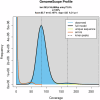Genome assembly and annotation of the parasitoid jewel wasp Nasonia oneida
- PMID: 40593889
- PMCID: PMC12215502
- DOI: 10.1038/s41597-025-05375-0
Genome assembly and annotation of the parasitoid jewel wasp Nasonia oneida
Abstract
The jewel wasp, Nasonia (Hymenoptera: Pteromalidae), is a well-established model system for evolutionary genetics and host-microbial interactions. Here, we present the genome of N. oneida, a species lacking prior genomic characterization, using 10× Genomics linked-read (400× coverage), Illumina short-read (120× coverage), and transcriptome data (30× coverage). The assembled genome size is 267 Mb, comprising 4,675 scaffolds, with a scaffold N50 of 1 Mb and 98.40% Benchmarking Universal Single-Copy Orthologues (BUSCOs) completeness score. Annotation revealed 32.29% (86.46 Mb) of repetitive sequences and 14,221 protein-coding genes. Comparative genomics of N. oneida with 15 other hymenopteran species validated the presence of 5,939 gene families shared among them, including 3643 single-copy and 2296 multicopy gene families. This study provides the first de novo assembly of N. oneida, providing a significant addition to the growing repertoire of molecular tools for comparative genomics and functional studies to understand the evolution of closely related species as well as the evolution of parasitic wasps.
© 2025. The Author(s).
Conflict of interest statement
Competing interests: The authors declare no competing interests.
Figures





Similar articles
-
Chromosome-level genome assembly of Protandrena (Anthemurgus) passiflorae (Hymenoptera: Andrenidae), a host-plant specialist bee.G3 (Bethesda). 2025 Jul 9;15(7):jkaf096. doi: 10.1093/g3journal/jkaf096. G3 (Bethesda). 2025. PMID: 40317167 Free PMC article.
-
OGS2: genome re-annotation of the jewel wasp Nasonia vitripennis.BMC Genomics. 2016 Aug 25;17(1):678. doi: 10.1186/s12864-016-2886-9. BMC Genomics. 2016. PMID: 27561358 Free PMC article.
-
Chromosome-level genome assembly and annotation of the pygmy grasshopper Gibbotettix parvipulvillus.Sci Data. 2025 Jul 1;12(1):1119. doi: 10.1038/s41597-025-05474-y. Sci Data. 2025. PMID: 40592903 Free PMC article.
-
Here We Are, But Where Do We Go? A Systematic Review of Crustacean Transcriptomic Studies from 2014-2015.Integr Comp Biol. 2016 Dec;56(6):1055-1066. doi: 10.1093/icb/icw061. Epub 2016 Jul 8. Integr Comp Biol. 2016. PMID: 27400974 Free PMC article.
-
Risk of thromboembolism in patients with COVID-19 who are using hormonal contraception.Cochrane Database Syst Rev. 2023 Jan 9;1(1):CD014908. doi: 10.1002/14651858.CD014908.pub2. Cochrane Database Syst Rev. 2023. Update in: Cochrane Database Syst Rev. 2023 May 15;5:CD014908. doi: 10.1002/14651858.CD014908.pub3. PMID: 36622724 Free PMC article. Updated.
References
-
- Huber, J. Biodiversity of Hymenoptera. In Insect Biodiversity. (eds R.G. Foottit and P.H. Adler) 419–461 (2017).
-
- Peters, R. S. et al. Evolutionary History of the Hymenoptera. Current Biology27, 1013–1018 (2017). - PubMed
Publication types
MeSH terms
Grants and funding
LinkOut - more resources
Full Text Sources
Miscellaneous

